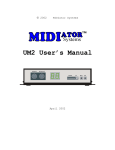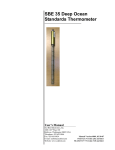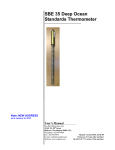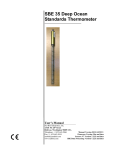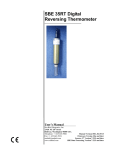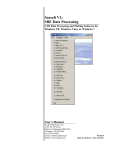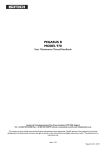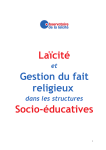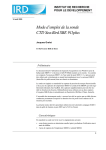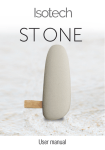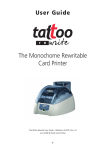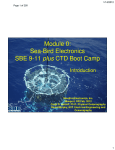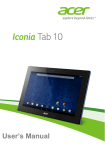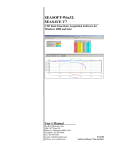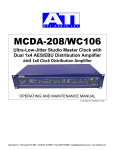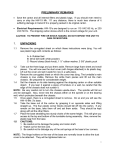Download Manual - Communication Technology
Transcript
SBE 35 Deep Ocean Standards Thermometer User’s Manual Sea-Bird Electronics, Inc. th 1808 136 Place NE Bellevue, Washington 98005 USA Tel: 425/643-9866 Fax:425/643-9954 1 Limited Liability Statement Extreme care should be exercised when using or servicing this equipment. It should be used or serviced only by personnel with knowledge of and training in the use and maintenance of oceanographic electronic equipment. SEA-BIRD ELECTRONICS, INC. disclaims all product liability risks arising from the use or servicing of this system. SEA-BIRD ELECTRONICS, INC. has no way of controlling the use of this equipment or of choosing the personnel to operate it, and therefore cannot take steps to comply with laws pertaining to product liability, including laws which impose a duty to warn the user of any dangers involved in operating this equipment. Therefore, acceptance of this system by the customer shall be conclusively deemed to include a covenant by the customer to defend, indemnify, and hold SEA-BIRD ELECTRONICS, INC. harmless from all product liability claims arising from the use or servicing of this system. 2 Table of Contents Section 1: Introduction About this manual………………………………...4 How to contact Sea-Bird………………………….4 Section 2: Communication with the SBE 35 …….....5 System Description..………………………………5 Communication with SBE 35..……………………6 Section 3: SBE 35 Commands Status………………………………………………7 Set Up...……………………………………..…….7 Acquisition….……………………………………..8 Data Upload.………………………………….…...9 Calibration Coefficients…………………………...9 Testing…………………………………………….9 Section 4: Operating the SBE 35 Operation with CTD’s and Carousel Water Sampler…..……………………...10 Use with SBE 911plus and Carousel Water Sampler……….…………………10 Use with SBE 19 or 25 CTD and Carousel Water Sampler…...……...………………………..11 Operation with Fixed-Point Cells………………...12 Section 5: Measurement Cycle…………………….....13 Section 6: Calibration………………………………....14 Fixed-Point Calibration Status…………………...15 Figure Descriptions Figures 1-3 References Warranty Policy Service Information Calibration Certificates 3 1:Introduction Section 1: Introduction This section includes contact information and manual version number. About this manual This manual is to be used with the SBE 35 Deep Ocean Standards Thermometer. It is organized to guide a user from installation through operation and data collection. We’ve included command descriptions, measurement cycle and calibration information. If you have any questions, do not hesitate to contact us at the numbers below. Manual Version # 005 03/30/99 How to contact Sea-Bird Sea-Bird Electronics, Inc. 1808 136th Place Northeast Bellevue, Washington 98005 USA Telephone: 425-643-9866 Fax: 425-643-9954 E-mail: [email protected] Website: http://www.seabird.com Our business hours are: Monday-Friday, 0800 to 1800 Pacific Standard Time (1600 to 0200 Universal Time) Except from April to October, when we will be on “summer time” (1500 to 0100 Universal Time) 4 2:Communication with the SBE 35 Section 2: Communication with the SBE 35 This section describes the function and set up of the SBE 35. System Description The SBE 35 is an accurate ocean-range temperature sensor that can be standardized against water triple point and gallium melt cells as if it were an SPRT, but is also capable of measuring temperature in the ocean. When used with a SBE 911plus, SBE 19, or SBE 25 CTD and Carousel water sampler, the SBE 35 makes a temperature measurement each time a bottle fire confirmation is received and stores the value in EEPROM. Each stored value contains the time of day and the bottle position in addition to the temperature data to facilitate comparison of the SBE 35 record with CTD and water bottle data. The SBE 35 can use the built in CTD modem channel for two-way communications. It is not necessary to change cable connections to communicate and retrieve data from the SBE 35. Supplied with the SBE 35 is a powerful software package, SEASOFT, which enables the user to communicate, retrieve data, and to calculate and display temperature. SEASOFT as supplied is designed to run on IBM XT/AT/386/486/Pentium or compatible computers. A separate software manual contains additional information on the setup and use of SEASOFT. 5 2:Communication with the SBE 35 Communication with the SBE 35 Use the program TERM35 supplied with the SBE 35 (or any other terminal program set to 300 baud, 8 data bit, no parity) to communicate with the SBE 35. For lab use : 1. Connect the SBE 35 to a SBE 90248 opto-box using cable P/N 80555. The opto-box isolates power to the SBE 35 and buffers the serial communication lines in order to minimize noise input to the SBE 35 from external sources. 2. Connect the 90248 to a serial port on a PC with a straight through cable P/N 80677. The SBE 35 communicates at 300 baud, 8 data bits, no parity. Note: The orange LED will flash when the SBE 35 transmits. The green LED will flash when the PC transmits. 3. The SBE 35 will transmit "SBE 35 wake up" three seconds after the 90248 opto-box is powered on. 7 2:Communication with the SBE 35 Section 3: SBE 35 Commands This section describes the commands associated with TERM35 as part of SEASOFT. Command Descriptions STATUS Display Status. A typical reply would be: ds SBE35 V 2.0 SERIAL NO. 0013 01 Oct 1998 15:56:52 number of measurement cycles to average = 8 number of data points stored in memory = 2 bottle confirm interface = SBE 911plus S> Display Calibration Coefficients. A typical reply would be: dc SBE35 V 2.0 SERIAL NO. 0013 09-apr-97 A0 = 5.156252707e-03 A1 = -1.430180396e-03 A2 = 2.092145355e-04 A3 = -1.156278215e-05 A4 = 2.446454055e-07 SLOPE = 1.000000 OFFSET = 0.000000 S> SET UP Set the number of measurement cycles per acquisition to N. Each acquisition cycle is 1.1 seconds in duration. In a thermally quiet environment the temperature noise standard deviation is: ncycles=N 0.000029 * sqrt(8 / ncycles) °C interface=911plus SBE 35 is used with a SBE 911plus CTD and Carousel interface=32serial SBE 35 is used with a SBE 19 or 25 CTD and Carousel samplenum=N Set the sample number to N. Set N to 0 at the beginning of a cast after all previous data has been downloaded from the SBE 35 8 3: SBE 35 Commands DDMMYY=ddmmyy MMDDYY=mmddyy Set current day, month, and year. This command must be followed by HHMMSS= command to set the time. Set current month, day, and year. This command must be followed by HHMMSS= command to set the time. DDMMYY= and MMDDYY= commands are equivalent. Either one can be used to set the date. HHMMSS=hhmmss Set the current hour, minute, and second. Example: To set the current date and time to 10 January 1997 12:00:00: MMDDYY=011097 HHMMSS=120000 or DDMMYY=100197 HHMMSS=120000 ACQUISITION Bottle Confirm Whenever the SBE 35 receives a valid bottle confirmation sequence (a character with decimal value 6 followed by a character with decimal value greater than 48 and less than 84) it takes a measurement ncycles in duration and stores the date, time, bottle number, maximum - minimum thermistor value, and sensor output in EEPROM. ts Take one sample and store it in EEPROM cal Sample continuously, do not compute temperature, do not store samples Output Format: column 1: column 2: column 3: column 4: column 5: column 6: column 7: zero value reference resistor value thermistor value maximum - minimum zero value maximum - minimum reference resistor value maximum - minimum thermistor value sensor output (n) A typical output with the SBE 35 in a triple point of water cell with the number of cycles per measurement = 16 is: 197.21 197.87 197.64 198.08 197.73 197.91 197.71 1047557 1047563 1047565 1047566 1047554 1047555 1047551 8 752453.3 752457.4 752459.1 752459.9 752451.2 752451.4 752449.1 15 15 15 19 13 17 14 31 31 32 30 34 30 27 27 21 18 21 28 27 21 753130.0 753129.0 753129.5 753129.5 753129.6 753129.2 753129.2 3: SBE 35 Commands run Sample continuously, compute temperature, do not store samples The output format is the same as in Page 8 but with computed temperature added in the eighth column. Although the total time per measurement cycle is 1.1 * ncycles seconds the time between sample updates is 1.1 * ncycles + 2.7 seconds. The extra time is spent converting the measured values to computed temperature and transmitting the data at 300 baud. DATA UPLOAD Dump all the data dd ddB,E Dump scans B through E The format is: column 1: column 2,3: column 4: column 5: column 6: column 7L sample number date and time DD MMM YYYY HH:MM:SS bottle position maximum - minimum thermistor value sensor output (n) computed temperature [ITS-90] A sample output with the SBE 35 taking data in room ambient air is: 1 30 Sep 1998 16:15:13 bn = 8 diff = 19 val = 509867.0 t90 = 8.752364 2 30 Sep 1998 16:15:41 bn = 6 diff = 21 val = 509867.4 t90 = 8.752342 0 1 2 3 4 5 30 Sep 1998 10:29:29 30 Sep 1998 10:31:00 30 Sep 1998 10:31:30 30 Sep 1998 10:32:00 30 Sep 1998 10:32:30 30 Sep 1998 10:33:00 bn = bn = bn = bn = bn = bn = 1 2 3 4 5 6 diff = diff = diff = diff = diff = diff = 268 84 140 357 367 409 val = val = val = val = val = val = 278061.1 277430.6 277357.8 277163.3 277055.7 276487.1 CALIBRATION COEFFICIENTS caldate=sssss ta0=F ta1=F ta2=F ta3=F ta4=F offset=F slope=F set the calibration date to sssss (factory programmed) set A0 coefficient = F (factory programmed) set A1 coefficient = F (factory programmed) set A2 coefficient = F (factory programmed) set A3 coefficient = F (factory programmed) set A4 coefficient = F (factory programmed) set the offset to F set the slope to F TESTING *rtctest Test battery backed static RAM in the real-time clock module. *eetest Test the EEPROM memory. Allow 30 seconds for this test to complete. This command will destroy all data stored in the EEPROM and will overwrite the calibration coefficients! Both the *rtctest and *eetest overwrite data stored in the SBE 35 SRAM! Re-set the date, time, and number of cycles to average after running these commands. 9 4: Operating the SBE 35 Section 4: Operating the SBE 35 This section will describe SBE 35 operation with Sea-Bird CTD’s and the Carousel Water Sampler, and fixed-point cells. Operation with CTD’s and Carousel Water Sampler At sea, the SBE 35 can act as a stand-alone substitute for a reversing thermometer, recording temperature with each bottle closing. In this application, the SBE 35 is mounted in a secure area on the water sampler frame where the ocean water flushes freely and there is minimal contamination from the passive thermal mass of the metal frame or active thermal dissipation from electronic instruments. Alternately, the SBE 35 can be used as a in-situ temperature calibrator for the SBE 3plus temperature sensors used on the SBE 911plus or SBE 25 CTDs. In this application, the SBE 35 is mounted in the 3/35 calibration frame. This frame places the measurement tips of the SBE 35 and SBE 3 in a plenum duct through which an auxiliary pump draws a constant vigorous flow of the ambient seawater; this arrangement insures that temperature averages from both instruments correspond to the same water evaluated at the same time. Heat shed from the passive thermal mass of the CTD / water sampler frame and from active dissipation of electronic instruments can alter in-situ water temperature at small scales by several millidegrees. A temperature comparison is made each time a water bottle is closed. The best comparison measurements are expected in deep isothermal water. With good calibration locks of the SBE 35 in fixed point cells before and after a cruise, we expect the offset drift of the SBE 3 temperature sensor to be measured in-situ to a precision of better than 0.0005 °C. The SBE 35 has a time constant of 0.5 seconds so it will lag the SBE 3 if temperature is changing during the measurement internal. A first order correction is: Determine the temporal gradient during the measurement interval from the secondary SBE 3 temperature data in the .ROS file (g = temperature gradient [°C/s]). Gradient-corrected SBE 35 temperature = SBE 35 measured temperature + 0.5 * g. Use with a SBE 911plus and Carousel Water Sampler 1. Connect the SBE 11plus deck unit modem channel to a PC using a straight through serial cable (P/N 80073). 2. Connect the SBE 35 to the SBE 9plus and Carousel water sampler using cable Ycable SBE 171220, DWG 32208. The three arms of the Y-cable are labeled SBE 9, SBE 32, and SBE 35. Connect each arm to the proper device. For the calibration comparison application mount the SBE 35 (without tip bushing), the desired secondary SBE 3, and 1200 rpm secondary pump into the 3/35 calibration frame that is supplied. 10 4: Operating the SBE 35 (Use with SBE 911plus continued…) 3. Power the SBE 9plus with the 11plus deck unit. 4. Run TERM 35 and send the display status command (DS) to verify communication with the SBE 35. (If no reply is received; press <F2> to bring up the setup form, select communication set up and check the COMM port setting.) In addition, check that the bottle confirm interface is correct for the application. If not, type “interface=” and either 911plus or 32 serial. 5. Set samplenum to zero and run SEASAVE to acquire the CTD cast. 6. The SBE 35 will take a sample each time it receives a bottle confirmation and store the data in EEPROM. If a second bottle is fired before the SBE 35 finishes sampling (1.1 * ncycles + 2 seconds), the SBE 35 will ignore the second bottle confirmation. 7. After the CTD cast, run TERM 35. Press Function Key 9 to upload the data. The data file will be stored with a .ASC extension. 8. Run DATCNV. In Water Bottle Set Up, select scans marked with bottle confirm bit as the source of scan range. Set offset to 0.0 and duration = 1.1 * ncycles. Use with a SBE 19 or 25 CTD and Carousel Water Sampler 1. Connect the SBE 33 deck unit modem channel to a PC using a straight through serial cable (P/N 80073). 2. Connect the SBE 35 to the Carousel water sampler using cable SBE 171221 DWG 32209. This is not a straight through cable. Connect the end labeled SBE 35 to the SBE 35 and the end labeled SBE 32 to the Carousel. For the calibration comparison application mount the SBE 35 (without tip bushing), the desired secondary SBE 3, and 1200 rpm secondary pump into the 3/35 calibration frame that is supplied. 3. Power the Carousel with the SBE 33 deck unit. 4. Run TERM 35 and send the display status command (DS) to verify communication with the SBE 35. (If no reply is received; press <F2> to bring up the setup form, select communication set up and check the COMM port setting.) In addition, check that the bottle confirm interface is correct for the application. If not, type “interface=” and either 911plus or 32serial. 5. Set samplenum to zero and run SEASAVE to acquire the CTD cast. 6. The SBE 35 will take a sample each time it receives a bottle confirmation and store the data in EEPROM. If a second bottle is fired before the SBE 35 finishes sampling (1.1 * ncycles + 2 seconds), the SBE 35 will ignore the second bottle confirmation. 7. After the CTD cast, run TERM 35. Press Function Key 9 to upload the data. The data file will be stored with a .ASC extension. 8. Run DATCNV. In Water Bottle Set Up, select scans marked with bottle confirm bit as the source of scan range. Set offset to 0.0 and duration = 1.1 * ncycles. 11 4: Operating the SBE 35 Operation in Fixed-Point Cells For calibration measurements in thermodynamic fixed point cells, a brass and white plastic tip bushing is used to give the SBE 35 a length, diameter, and thermal averaging characteristic that mimics the standards-grade platinum resistance thermometer (SPRT). 1. 2. 3. 4. 5. 6. 7. 8. 9. Connect the SBE 35 to the 90248 opto-box and run TERM35. Press <Enter>, and the 'S>' prompt should be displayed. Use the NCYCLES command to change the number of cycles to average. Fill the brass and white plastic tip bushing with the same thermal transfer fluid used in the fixed point cell (ex. de-ionized water with 2% isopropyl alcohol). Use a syringe to fill the tip bushing from the bottom so that air bubbles are not trapped inside. Screw the bushing onto the SBE 35 probe tip and place the probe in the cell. Adjust the SBE 35 probe temperature to ≤ 1°C warmer than the fixed point temperature to make sure the inner melt of the fixed point cell is maintained. Type RUN to start continuous sampling. Press <F5> to start capturing data. Data from the SBE 35 will be displayed on the screen and written to a file on disk. Use an editor to extract the stable converted data of interest. 12 5: Measurement Cycle Section 5: Measurement Cycle This section provides description of measurement cycle for the SBE 35. The SBE 35 determines temperature by applying a 1.2 kHz AC excitation to a reference resistor, zero ohms and an ultrastable thermistor and digitizing the output from each with a 20 bit delta-sigma A/D converter. The reference resistor is a hermetically sealed VISHAY VHP202K inside a temperature-controlled oven. The switches are "All-Position" mercury wetted reed relays with a stable contact resistance. AC excitation and ratiometric comparison using a common processing channel removes measurement errors due to parasitic thermocouples, offset voltages, leakage currents, and gain errors. Maximum power dissipated in the thermistor is 5e-7 watts. NR NZ NT output from the reference resistor output from zero ohms output from the thermistor Output from the sensor = 1048576 * (NT - NZ) / (NR - NZ) Each acquisition cycle is: select zero ohms, wait 0.1 seconds for the output to stabilize average for 0.267 seconds, this is NZ select reference resistor, wait 0.1 seconds for the output to stabilize average for 0.267 seconds, this is NR select thermistor, wait 0.1 seconds for the output to stabilize average for 0.267 seconds, this is NT The total time per cycle is 1.1 second. The number of the above acquisition cycles per measurement is programmable. Increasing the number of cycles per measurement increases the time to acquire the sample while reducing the RMS temperature noise from the sensor. The following RMS noise values are typical for a SBE 35 in a triple point of water cell: Ncycles Acquisition Time 8 32 8.8 seconds 35.2 seconds Standard Deviation (°C) 0.000029 0.000014 Temperature is computed using the Steinhart-Hart polynomial for thermistors (Steinhart and Hart, 1968; Bennett, 1972) as follows (n is the output from the SBE 35): t90L = 1.0 -273.15 a0 + a1ln(n) + a2ln2(n) + a3ln3(n) + a4ln4(n) t90 = slope x t90L + offset [deg C, ITS-90] Carrying the polynomial to fourth order captures the non-linearity of the SBE 35 thermistor output to better than ± 0.0001 °C. (See Figure 1 in back of manual) 13 6: Calibration Section 6: Calibration Following the methodology used for standards-grade platinum resistance thermometers (SPRT), the calibration of the SBE 35 is accomplished in two steps described below. This section also describes fixed-point calibration. Note: Figures 1-3 are located in back of manual. The first step is to characterize and capture the non-linear resistance vs temperature response of the sensor. Because it is important that "fit" equations reflect underlying physical mechanisms, the Steinhart-Hart equation is a good choice. By including terms through fourth order, this equation characterizes the SBE 35 output to an error less than ± 0.0001 °C (Figure 1). Unlike SPRTs, where the basic non-linear calibration equation has fixed coefficients that apply to all thermometers, thermistors require individualized coefficients to the Steinhart-Hart equation because unlike pure SPRT platinum the thermistor material is an individualized mix of dopants. The individualized SBE 35 calibrations are performed at Sea-Bird in a low-gradient temperature bath and against ITS90 certified SPRTs maintained at Sea-Bird's primary temperature metrology laboratory. The calibration process is described below. The second step is frequent certification of the sensor by measurements in thermodynamic fixed-point cells. Triple point of water (TPW) and gallium melt point (GaMP) cells are appropriate for the SBE 35, which is designed for ocean range temperatures (-5 to 35 °C). Like SPRTs, the slow time drift of the SBE 35 is adjusted by a slope and offset correction to the basic non-linear calibration equation. The Sea-Bird primary temperature standard consists of two Yellow Springs Instruments standards-grade platinum resistance thermometers (YSI-8163Q s/n 4747, 4749) maintained and used exclusively in the temperature range -5 to 40 °C. SPRT resistance ratios are measured with a Automated Systems Laboratory ASL-F18 resistance bridge using methodology of the US National Institute of Standards and Technology (NIST) Primary Temperature Standards Laboratory. The SPRTs are calibrated and certified against a group of four triple-point of water cells (Jarrett s/n 461, 716, 1682, 1683) and one gallium melt-point cell (Isotech s/n 114). A second gallium melt cell from the US NOAA Calibration Laboratory is also periodically used. Following NIST methodology, the TPW cell mantles are prepared and stress-annealed for two weeks before use. The cells are maintained in a temperature bath held at +0.008 °C where they are used for several months before the mantles must be melted and rebuilt. The thermal transfer fluid used in the cell thermometer wells and maintenance bath is de-ionized water with 2% isopropyl alcohol and a brass bushing (5 cm length) is used to couple the SPRT to the TPW thermometer well wall. The gallium melt cells are cycled through a 100% melt in a commercial Isotech gallium furnace. De-ionized water and a brass bushing are used as the thermal transfer media in the thermometer well. The inner melt of the gallium ingot is initiated by injecting 58 °C de-ionized water into the thermometer well and thermometers are pre-heated to above 30 °C before insertion to insure the inner melt is preserved. The June 1995 calibration checks of SPRT s/n 4747 (used to calibrate the SBE 35) show it to be within ±0.000050 °C of ITS-90. We expect SPRT readings at 15 °C to be within ±0.000100 °C of ITS-90. 14 6: Calibration The SBE 35 obtained its linearization calibration in a bath used to calibrate the Sea-Bird temperature transfer standards to our SPRTs. The bath is a computer controlled, highly insulated bath of 50 liters volume, stirred and mixed to obtain temperature uniformity of better than ±0.000250 °C. Calibrations are made at 11 points equally spaced from -1.5 to 32.5 °C. At each point, the bath is allowed to equilibrate for one hour. When the computer judges bath stability and variance to be acceptable, a 600-second synchronous integration of data from all sensors is obtained and tested for conformance to high stability and variance criterion. The 600-second integrations are repeated until all data pass the test and the computer then moves the bath to the next temperature point. Experiments indicate that the calibration transfer error from the SPRT to other sensors is within ±0.000250 °C. The total accuracy of calibration is expected to be within ±0.000500 °C. The results of the SBE 35 calibration are shown in Figure 1. "Bath temperature" is obtained from the SPRT (s/n 4747). The Steinhart-Hart equation taken to 4-th order fits the calibration data to within ±0.000100 °C. While temperatures are reported to microdegree level we believe the reliable resolution of temperature with this system is presently about ±0.000025 °C. The time-drift rate of the SBE 35 is expected to be less than ±0.001 °C/year based on bench tests of the circuit and our experience with the super-stable SP-60 thermistors in other Sea-Bird instruments (e.g. SBE 16). It is possible that the initial drift of the sensor will exceed the anticipated limit for a few months due to manufacturing stresses placed on circuit components. Fixed-Point Calibration (Slope and Offset) As with SPRT methodology, the basic certification of the SBE 35 sensor is performed by calibration measurements in thermodynamic fixed point cells. The slope and offset terms are determined by placing the SBE 35 in triple point of water and gallium melt point cells after the SBE 35 has been linearized. The number of cycles to average was set to 16. IMPORTANT: Set the slope to 1.0 and the offset to 0.0 using the slope= and offset= commands before performing the fixed point calibration. Figure 2 shows data taken in a triple point cell. Figure 3 shows the gallium melt curve. The reported temperatures are calculated using the 29-Jun-95 linearization with slope set to 1.0 and offset set to 0.0. Triple Point Of Water: Defined temperature ITS-90 Hydrostatic head effect 0.010000 °C -0.0073 mdeg / cm In our triple point of water cell (Jarrett 1982) the hydrostatic head is -0.000198 °C, thus true measured temperature in triple point of water: tt = 0.010000 - 0.000198 = 0.009802 °C and actual measured temperature from SBE 35: mt = 0.009626 °C 15 6: Calibration Gallium Melt Point Defined temperature ITS-90 Hydrostatic head effect Atmospheric pressure effect 29.764600 °C -0.01165 mdeg / cm -2.0µK / millibar In our gallium melt point cell (Isotech 114) the hydrostatic head is -0.000272 °C and the barometric pressure was approximately 1010 millibars, thus true measured temperature in the gallium cell: tg = 29.764600 - 0.000272 + 0.000007 = 29.764335 °C and actual measured temperature from SBE 35 (using a 60 minute average beginning 8.5 into the melt cycle: mg = 29.764336 °C slope = (tg - tt) / (mg - mt) = 0.999994 offset = tt - (slope * mt) = 0.000176 Program the new slope and offset into the SBE 35 using the slope= and offset= commands. 16 Figure Descriptions 1. Sea-Bird calibration certificate for SBE 35 s/n 1. The coefficients are for the 29-Jun-95 calibration data. Bath temperatures were measured with Sea-Bird's SPRT (s/n 4747) calibrated 03 January 1995 and showing recent triplepoint of water and gallium melt point checks within ±0.000050 of correct. We expect the transfer errors in the bath to be within ±0.000250 °C. The overall calibration accuracy is expected to be within ±0.000500 °C. 2. 48-hour time series of measurements of SBE 35 s/n 1 in a triple-point of water cell (TPW s/n Jarrett 1682). The TPW cell is maintained in a strain-annealed state in a stirred water bath at 0.008 °C. In the TPW thermometer well, the thermal transfer fluid is de-ionized water with 2% isopropyl alcohol and a brass bushing of 5 cm length is used for good thermal contact between the measurement section of the SBE 35 (including its tip bushing) and the thermometer well wall. The SBE 35 data were acquired with the 29-Jun-95 calibration coefficients and Ncycles=16 and the data set further averaged with the program BINAVG using bin=16 scans. The average measured temperature was 0.009626 °C. 3. 11-hour time series of measurements of SBE 35 s/n 1 in a gallium melt point cell (GaMP s/n Isotech 114). The GaMP cell is melted in a Isotech gallium oven. The thermal transfer fluid is de-ionized water injected at a temperature of 58 °C to insure an inner melt. A thermometer well brass bushing is also used in the gallium cell. The SBE 35 was inserted into the well at about 35 °C to preserve the inner gallium melt, and data were acquired with the 29-Jun-95 calibration coefficients and Ncycles=16. Before plotting the data were further averaged with BINAVG using bin=16 scans. The melt plateau temperature is taken to be the average of temperatures on the upper plateau between hours 8.5 to 9.5 and is 29.764336 °C. I References References Steinhart, J.S. and Hart, S.R. (1968) "Calibration Curves for Thermistors", Deep-Sea Research, 15, p.497. Bennett, A.S. (1972) "The Calibration of Thermistors over the Temperature range 0-30 °C", Deep-Sea Research, 19, p.157. II






















